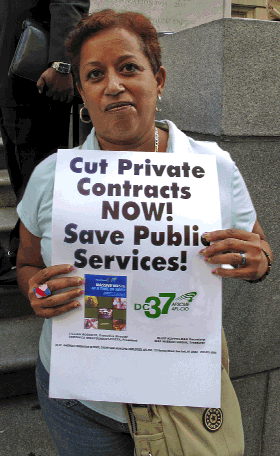By GREGORY N. HEIRES
In his best-selling book “Capital in the 21st Century,” French economist Thomas Piketty identifies privatization as one of the causes of global inequality.
Indeed, the sell-off of public assets in the former Soviet Bloc, Europe and Latin America has lined the pockets of the wealthy as the wages of workers have stagnated and dropped.
In the United States, privatization is also exacerbating the gap between the 1 percent and the rest of us. But privatization in the United States refers more to the contracting out of public services than to the sale of public assets.
A report by In the Public Interest released on June 3 takes a critical look at privatization in the United States. It describes how outsourcing by state and local governments is causing the erosion of the middle class.
“Race to the Bottom: How Outsourcing Public Services Rewards Corporations and Punishes the Middle Class” examines case studies from across the country that show how contracting out public services in effect forces taxpayers to contribute to income inequality and the lowering of the quality of services in their own communities.
“Unfortunately, when these services are outsourced to private companies, the subsequent contracted positions offer lower wages, reduced benefits and little or no retirement security,” the report says.
“Too many times, these positions turn into poverty-level jobs because companies pay workers low wages and provide little or no benefits in an effort to reduce their own operating costs. These jobs that provide vital public services and are paid for with taxpayer dollars, yet the men and women working for contractors are provided with wages that do not allow them to support their families.”
Proponents claim they want to save taxpayer dollars by doling out public services to contractors and non-profits. But the evidence of savings isn’t conclusive; in reality, privatization is about shrinking the role of government in our society.
Most states and local governments do not track how many contractors they employ. But a lot is at stake with privatization.
State and local governments award an estimated $1.5 trillion in contracts every year, which means millions of jobs are created through state and local contracting, according to the report by In the Public Interest, a Washington, D.C.-based resource center on privatization and responsible contracting. Experts estimate that there are three times as many contracted employees as federal civil servants.
Destroying a Pathway to the Middle Class
Too often, though, the contracts go to union-free employers who pay lower wages and provide fewer benefits than public-sector employers. This elimination of public-sector jobs is destroying the pathway to the middle class that government has historically provided to women and minorities.
In New Orleans, Carol Sanders worked as a cook in the public school system for 28 years until cafeteria services were outsourced to the facility management company Aramark in 2010.
Sanders decided to take a job with the contractor even though that meant her pay would be cut from $28 an hour to $9 an hour and her hours would be reduced from full-time to 20 hours per week. She lost her medical care, because she couldn’t afford the plan offered by her new employer, and she needed to rely on $200 a month in nutritional assistance to get by. Then, two years later, Aramark laid her off.
Destroying Good Jobs
Besides looking at the impact of contracting out on school cafeteria workers, “Race to the Bottom” examines how it has hurt the livelihood of waste and recycling workers, correctional officers, custodial workers, transit employees, and health-care support staff. In virtually all instances, the contracting out of those public-service jobs has resulted in lower wages and reduced benefits. For example:
•The Metro School Board in Nashville, Tenn., outsourced the work of nearly 700 custodial and grounds keeping jobs to GCA Services Group in 2010. As a result, the compensation (wages and benefits) of those jobs fell by 32 percent.
• In 2009, Milwaukee County contracted out the work of nearly 90 housekeepers responsible for cleaning public buildings.
The county housekeepers earned between $13.95 and $15.75 an hour. They also received paid vacation, health care and dental care. Contracted housekeepers are paid $8 an hour without benefits.
Services sometimes also suffer.
For instance, compared with publicly-run prisons, private prisons have fewer correctional officers, a higher turnover rate and more escapes and drug use, according to a report by the Federal Bureau of Prisons. Several studies show that the rate of inmate recidivism is higher in privately run prisons.
In the Public Interest recommends that state and local governments adopt policies to put the brakes on the race to the bottom resulting from contracting out. These includes:
• requiring governments to do cost-benefit analysis studies before pursuing contracting
• forcing contractors to pay their workers a living wage and provide them with decent benefits
• making the contracting process more transparent to keep track of contracts and to study the impact of contracting on the wages and benefits of employees, and
• requiring governments to study the economic and social impact of contracting proposals before doling out the work.
“By implementing these policies, state and local governments can rebuild those ladders to the middle class that have eroded over the years,” the report concludes. “Instead of engaging in a race to the bottom, cities and states can ensure that taxpayer dollars used to pay people to perform public work result in solid family-supported jobs.”





